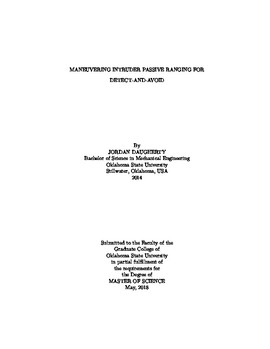| dc.contributor.advisor | Bai, He | |
| dc.contributor.author | Daugherty, Jordan | |
| dc.date.accessioned | 2019-05-08T18:36:52Z | |
| dc.date.available | 2019-05-08T18:36:52Z | |
| dc.date.issued | 2018-05-01 | |
| dc.identifier.uri | https://hdl.handle.net/11244/319627 | |
| dc.description.abstract | For the last two decades, unmanned aircraft systems (UAS) has seen much interest from both the civilian and military sector. As civilian applications expand, the issue of safety becomes more apparent. One major technical challenge currently facing UAS operations is properly sharing the national airspace with conventional aircraft. For safety purposes, it is necessary that UAS be able to properly detect intruding aircraft, including manned and unmanned aircraft, and avoid them. This requirement has been termed Detect-and-Avoid (DAA). We investigate the orbiting intruder passive ranging problem, where an ownship aircraft is moving with a constant velocity and the intruding aircraft is conducting an orbiting maneuver. We assume that the ownship measures the bearing angles to the intruder aircraft. We approach the problem utilizing a filter bank algorithm parameterized with respect to the range, the heading of the intruder, and the angular velocity. We test the performance of the filter bank algorithm using two different system models. The first system model comprises of the relative position in Cartesian coordinates and velocities in polar coordinates. The second system model is the modified polar coordinates. We conduct Monte Carlo simulations and utilize the root mean square error over time to determine the best parameterization of the filter algorithm for both system models. The results show that the system model in Cartesian coordinates performs better when estimating the range while the modified polar coordinates achieves better estimates for the heading of the intruder. We find that the filter in the modified polar coordinates exhibits more divergent behavior than the system in Cartesian coordinates. After an investigation of the orbiting intruder problem, we investigate the maneuvering intruder problem. Often the intruder's trajectory will follow segments of straight legs and orbits legs. We introduce a way to integrate our filter bank algorithm onto a Interacting multiple models framework. We utilize a constant velocity model on a single EKF. We implement a mixing strategy, where the IMM mixing stage will mix at a certain rate. We conduct a simulation study to identify the effects of varying mixing rate and the values of the model transition probability. We find that the model transition probability has the largest effect on performance. Finally, we show preliminary results of our algorithm's performance on flight test data. | |
| dc.format | application/pdf | |
| dc.language | en_US | |
| dc.rights | Copyright is held by the author who has granted the Oklahoma State University Library the non-exclusive right to share this material in its institutional repository. Contact Digital Library Services at lib-dls@okstate.edu or 405-744-9161 for the permission policy on the use, reproduction or distribution of this material. | |
| dc.title | Maneuvering Intruder Passive Ranging for Detect-and-Avoid | |
| dc.contributor.committeeMember | Jacob, Jamey D. | |
| dc.contributor.committeeMember | Kamalapurkar, Rushikesh | |
| osu.filename | Daugherty_okstate_0664M_15762.pdf | |
| osu.accesstype | Open Access | |
| dc.description.department | Mechanical and Aerospace Engineering | |
| dc.type.genre | Thesis | |
| dc.type.material | Text | |
